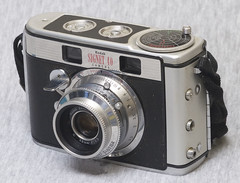Difference between revisions of "Kodak Signet 40"
m (Initial authoring) |
|||
| Line 6: | Line 6: | ||
}} | }} | ||
| − | The Kodak Signet 40 is a 35 mm rangefinder camera produced from 1956 to 1959. It has a coated (Lumenized!)Kodak Ektanon f/3.5 F=46mm lens mounted in a Kodak Synchro 400 shutter, with speeds of 1/5 to 1/400th sec. plus bulb. It originally sold for $65. | + | The Kodak Signet 40 is a 35 mm rangefinder camera produced from 1956 to 1959. It has a coated (Lumenized!) unit focusing Kodak Ektanon f/3.5 F=46mm lens mounted in a Kodak Synchro 400 shutter, with speeds of 1/5 to 1/400th sec. plus bulb. The rangefinder system is essentially that of the upscale [[Kodak Signet 35]], although the body is largely bakelite with numerous metallic panels, inserts, and fittings. The focusing mount uses ball bearings, again like the Signet 35. The build quality is quite good; the Signet 40 is a substantially more robust camera then the model 30, 50, and 80 Signets. |
| + | |||
| + | |||
| + | An interesting fact is that the Signet 40's lens contains thorium oxide, and is in fact radioactive. | ||
| + | |||
| + | It originally sold for $65. | ||
Revision as of 02:19, 29 April 2008

|
| Kodak Signet 40 |
The Kodak Signet 40 is a 35 mm rangefinder camera produced from 1956 to 1959. It has a coated (Lumenized!) unit focusing Kodak Ektanon f/3.5 F=46mm lens mounted in a Kodak Synchro 400 shutter, with speeds of 1/5 to 1/400th sec. plus bulb. The rangefinder system is essentially that of the upscale Kodak Signet 35, although the body is largely bakelite with numerous metallic panels, inserts, and fittings. The focusing mount uses ball bearings, again like the Signet 35. The build quality is quite good; the Signet 40 is a substantially more robust camera then the model 30, 50, and 80 Signets.
An interesting fact is that the Signet 40's lens contains thorium oxide, and is in fact radioactive.
It originally sold for $65.